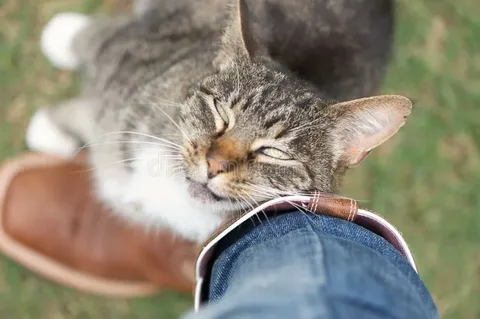Cats have been entrancing humans for thousands of years. From the tufts of their ears to the swish of their tails, it’s hard for us humans to ignore the mystery and beauty of cats. And if you’re looking for some amazing cat facts to share with your fellow cat-loving friends, we have you covered.

1- A cat blinking slowly at you shows its trust
Cats, like many other representatives of the animal world, use their eyes as one of the means of communicating their emotions. You may have seen two cats staring angrily at each other as if preparing themselves for a fight, you may have also noticed a cat looking closely into your own eyes and it must have even threatened you a little.
Turns out that in the cat world direct prolonged eye contact is a sign of a threat or challenge, while a cat blinking slowly at you means it is showing its trust and affection for you.
If you meet a cat for the first time you should be prepared to be studied by it first, and if it feels you are not any threat, it will ultimately look away and blink slowly, conveying its trust for you.

2- Purring can tell you a lot
Though it seems obvious that a normal cat must purr, we never really think about why they are doing this. Turns out purring is a very common way to communicate various emotions and even minor requests. First of all, cats purr when they are fully satisfied with what is going on with them: when a cat is in its favorite place, with a person it trusts by its side, not hungry and slowly falling asleep – it will not miss an opportunity to share its content with the world.
There are also cases when cats purr for a totally opposite reason – when they are hungry. Studies have proved that this is a different kind of sound, though it is also accepted as a purr. A hungry purr is slightly combined with a sound resembling a human baby cry (probably for a human to be ready to respond immediately to their master’s needs). So one should be more attentive not to miss their cat’s lunchtime.
Little kittens, even when they are just a couple of days old, use purr to tell their mother they are ok. Mother cats, on the other hand, use the same sound to calm down their kids. One can say that purr is a kind of cat lullaby. And no wonder sometimes a cat purring may easily put an adult human to sleep – those soft monotonous sounds can be impossible to resist.

Sometimes cats purr when they are nervous or even in pain. Various studies have proven that apart from calming a cat down, purring can help heal their bones and wounds by easing their breathing. No wonder cats are known to be good survivors, especially after falling from heights.
A good cat will also try to use the magical power of its purr on a sick human, and the healing effect is sometimes stunning, you just need to believe in your pet’s best intentions.

3- Cats only meow to humans
Cats are capable of producing around 100 various sounds to communicate with each other: they moan, more, murmur, chatter, howl, and purr. But turns out meowing – which seems to be the most obvious means of cat communication to us – is not particularly natural for these creatures.
Studies have proved that meowing has been developed as a way for cats to speak with humans, and is an adaptation of cats’ natural sound to human language. You will not hear any meowing in feral cats society, and nor will you see a cat ever meowing if it has not been brought up around people and developed this habit since being a little kitten.

4- Cat rubbing its face against you
It’s not a secret for anyone that cats are not like dogs: they are not as faithful as dogs, they will hardly ever show their affection for you, and will most likely stick to the master and slave model of behavior, with you being the latter of course. Still, they are not totally heartless.
Sometimes, if you really and truly deserve this, your cat might be kind enough to express some feelings, rubbing a face against your leg is the most obvious sign that your cat loves you. Cats also express their affection towards each other or greet their mates after they have been apart for some time through rubbing, so it’s a kind of analog of a human hug.

5- Cats and boxes: what’s the big deal?
The weird feeling cats have for boxes is not a secret to anyone. You may be buying your pet tons of special toys and will most likely see nothing but indifference and contempt in its bored eyes. But try leaving an empty box – small, large, new or old, stinky and frayed – and you’ve got your cat the best gift one could imagine. So what’s the deal with those boxes? A lot of researchers have been trying to solve this mystery, and yet there is still no definite answer.

Some of them say that cats as natural predators like to hide in boxes as if it’s easier for them to hunt from there – although if you have ever seen a cat in the box you may have noticed zero desire to do anything but sleep in their eyes. Others say that boxes imitating closed spaces help decrease a cat’s stress level, which seems to be more of a logical explanation.
Another explanation is that boxes help cats keep warm: cats are known to be way more tolerant to higher temperatures than humans and are probably just trying to make sure they will not get cold during a nice long nap they are taking in a box.

6- Cats dream just like humans
You may have seen your cat behaving weirdly while sleeping – trembling, moving legs, sometimes even a kind of smiling. Turns out seeing dreams is quite normal for cats. With sleeping an average of 16 to 18 hours per day cats must have a lot to experience additionally to what they have in reality.
Scientists say their dreams are pretty much like humans’, though less abstract. They are also believed to not completely distinguish between dreams and reality, so despite sleeping most of the time cats might have quite interesting lives.




